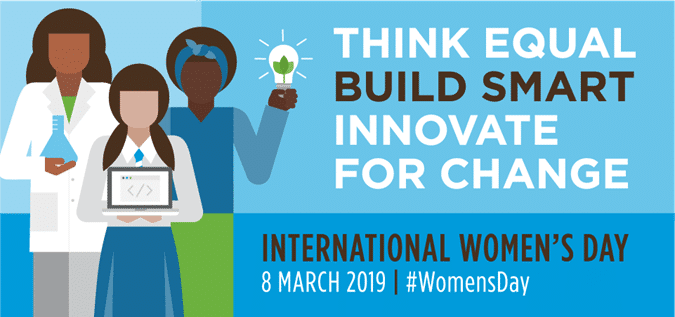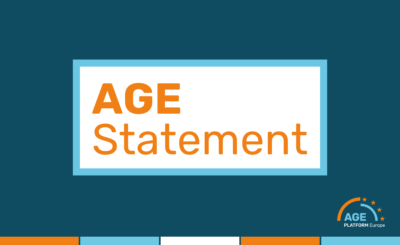The International Women’s Day is key to AGE as it is the opportunity to put additional focus on the issues faced by women in older age. According to research, ageism may now be even more pervasive than sexism. The consequences for individuals that are subject to both types of discrimination are thus tremendous. For 2019, AGE has decided to focus on the issue of health which clearly shows the need to dive into the intersectionality between age, sex and gender.
“While men die, women suffer”
As explained by Peggy Maguire in her blog for the #AgeingEqual campaign, women outlive men. They outlive men by six years (EU average, Eurostat 2016), but the difference in healthy life expectancy is only nine months. “This means that despite the increased life expectancy of women, their older years are disproportionately burdened by ill health”.

This difference is the result of the accumulation of discrimination faced by women over their life. And while women are thus more in need of support and long-term care, they face difficulties in meeting their care needs due to their lower financial resources. In pension age, older women face a gender pension gap of 38% (European Commission, Pension Adequacy Report 2018) relative to men.
This exposes them to higher risks of poverty and social exclusion in old age. In the age group 75+, older women face a risk of poverty and social exclusion of 23% versus 15% for older men. Low income in older age also means bigger difficulties to adapt ones’ home and live in a safe place (WHO, 2016). Still women are playing a central role in relation to care, notably as main provider of informal care up to a late stage of their life.
Incidence and prevalence of certain diseases among women
Both sex and gender have an important impact on people’s health. One the one hand, certain diseases affect differently women in comparison to men, like lung cancer, diabetes, depression or cardiovascular diseases (CVD).
[…] in women the symptoms of CVD can be different from these commonly observed ones and this, in addition to the prevalent believe that CVD is a male disease, may add to the under-recognition of CVD in women.
European Institute of Women’s Health, 2017
Research has also found that older women (women over the age of 70), are twice as likely to die from breast cancer compared with those patients under the age of 70. Similarly, chemotherapy effectiveness levels have been found to be lower for women over the age of 75. Moreover, older women have been found to be offered breast cancer surgery less than are their younger counterparts. Breast cancer surgery for women ages 60 to 80 is only advised when there are no or few co-morbidities as surgery can present major risks to the patient.
European Institute of Women’s Health, 2017
Women are also more likely to be diagnosed with breast cancer, osteoporosis, incontinence or dementia. In the case of dementia, a recent paper by the European Institute of Women’s Health (EIWH) recalls that education and employment – two areas where great gender differences still exist – are important dementia risk factors.
Assessing how biological and social influences specific impact women’s health is critical to ensure adequate prevention, diagnosis and treatment. Yet, women are under-represented in clinical trials – not to mention older women! – so that the adequacy of medicines for older women is weak with a greater risk of developing adverse drug reactions.
In order to address the above, AGE has joined forces with the European Institute of Women’s Health in 2011 for the revision of the clinical trials directive to advocate for more adequate trials and more recently AGE participated in the EIWH Women and Alzheimer Advisory Council.
A critical need for more research and disaggregated data
There are significant gaps in evidence and a need to improve availability and use of sex and age disaggregated data that can be crosslinked to social factors.
WHO Europe, 2016
While the specific sex and gender dimensions of health is no longer ignored, there is still a long way to go to further develop research and gather data in an intersectional approach with other socio-demographic variables, notably with ageing. In several domains, there are still few or even no data. It is for instance the case with regard to intimate partner violence: most data does not cover women over 60 and thus make an unknown phenomena also an invisible one.
The list of indicators aiming at monitoring the implementation of the Sustainable Development Goals illustrates how invisible older women are (cf. goal 3 “Ensure healthy lives and promote well-being for all at all ages” or goal 5 “Achieve gender equality and empower all women and girls”).
Looking at the rapid development around big data and artificial intelligence in health, it will be critical to bear in mind that the accumulation of inequalities over the lifespan and different lived experiences of some groups will water down the predictive and personalisation potential of AI if datasets do not reflect the diversity of the human population.
The motto chosen by the United Nations for the International Women’s Day 2019 is timely: “Think equal, build smart, innovate for change”. Indeed we first need to consider equality and to gather the right knowledge so that we can shape solutions that are really smart and implement initiatives that are truly innovative. Properly considering the intersectionality between age, sex and gender will be essential to deliver health equity.
Biological and social influences (sex and gender) are critical to health. Many factors outside of the health sector—such as socioeconomic status, education, culture and ethnicity—affect behaviour and resource access.
EU Manifesto for Women’s Health, 2018
Additional information
- #AgeingEqual Campaign: Ageism and gender (2018)
- WHO, Women’s health and well-being in Europe (2016)
- European Institute of Women’s Health
- Gender Equality in old age
- AGE press release to mark 2019 International Women’s Day
For more information on our work on healthy ageing, please contact Julia Wadoux, AGE Policy Coordinator: julia.wadoux@age-platform.eu







